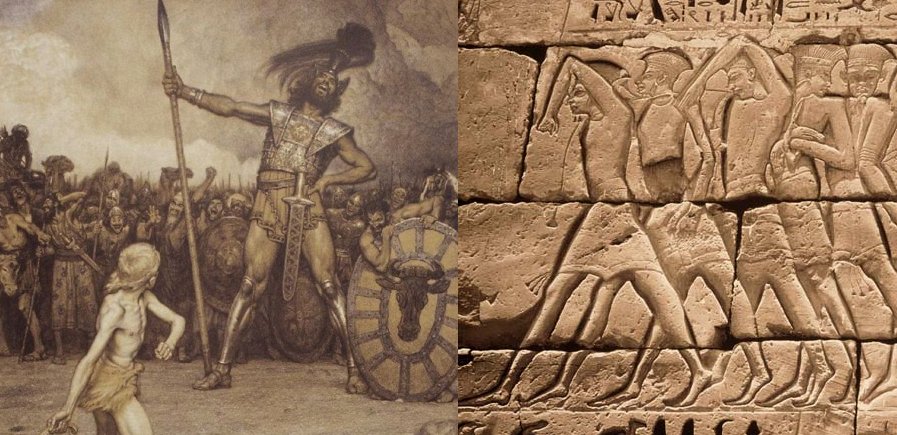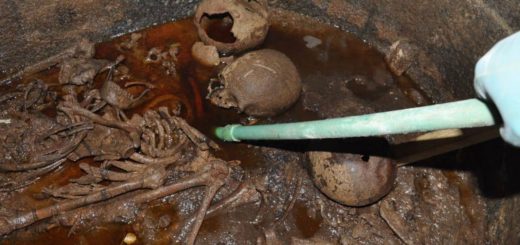Mystery Of The Philistines – Biblical Goliath People – New Clues Shed Light On An Ancient Enigma
– Who were the Philistines? Were they Biblical villains or simply enigmatic travelers? After the discovery of a large Philistine cemetery, researchers have now presented material that may shed new light on the mysterious Biblical Goliath people.

Philistines one of a people of Aegean origin who settled on the southern coast of Palestine in the 12th century B.C, about the time of the arrival of the Israelites. Were the Philistines came from is not entirely clear. According to Biblical tradition the Philistines came from Cathor. This could possibly have been the island of Crete, but no archaeological evidence of a Philistine occupation of the island has been discovered in this area.
The first mention of the Philistines has been tracked to ancient Egypt. On ancient Egyptians inscriptions in the temple of Ramses III at Madinat Habu these enigmatic people appear under the name prst, as one of the Sea Peoples that invaded Egypt about 1190 BCE after ravaging Anatolia, Cyprus, and Syria. After being repulsed by the Egyptians, they settled-possibly with Egypt’s permission-on the coastal plain of Palestine from Joppa (modern Tel Aviv-Yafo) southward to Gaza.
In 2015, archaeologists discovered structures and an entrance gate to the Philistine city of Gath, once home to the giant Biblical Goliath. The gate of Gath is referred to in the Bible (in I Samuel 21) in the story of David’s escape from King Saul to Achish, the King of Gath.
The ancient city of Gath, located in the Tel Zafit national park in the Judean foothills, was once a large city in the Philistines in the 10th century BCE. It was later destroyed in 830 BCE by Hazael, the king of Aram Damascus.
In July 2016, archaeologists reported an archaeological sensation. They had discovered a large cemetery of the Biblical people of the Philistines in the Israeli port of Ashkelon for the first time. Never before had an extensive burial ground of this type belonging to this legendary people been unearthed. The cemetery contained 145 corpses that gave researchers an opportunity to understand funeral customs of the Philistines. By collecting bones and extracting DNA researchers could learn how the Biblical people of Goliath lived and trace their ancient history.
Based on the discovery of ancient red-and-black pottery, archaeologists suggested that the Philistines may have come from the Mycenaean civilization of the Aegean, one of the greatest civilizations of Greek prehistory, famous for its majestic architecture and imposing monuments.
According to archaeologist Daniel Master, in charge of the site excavated since 1985 under the Leon Levy Expedition, affiliated with Harvard University’s Semitic Museum the Philistines were strangers in the Semitic region,” where their presence between 1200 and 600 BC is evident on a thin coastal strip running from present-day Gaza to Tel Aviv”.
The origins of the Philistine people have long been shrouded in mystery.
Before the discovery of the large cemetery there were few archaeological discoveries that help historians to piece together the history of this mysterious ancient civilization.
The Philistines are known mostly from the Old Testament account given by their neighbors and bitter enemies, the ancient Israelites.
In the Book of Samuel there are accounts of the capture by Philistine fighters of the Ark of the Covenant and the duel between their giant warrior Goliath felled by a stone from David’s sling.
From these Biblical descriptions of savage marauders comes the modern usage of “philistine” to mean a person without culture or manners.
Scientists who examined the ancient skeletons of the Philistine people buried at the Ashkelon cemetery, say they have found no evidence they were giants. However, their bones indicate they were hard workers. They practiced inbreeding and they used their teeth as tools, probably in the weaving industry. Many individuals showed signs of growth disorders, malnutrition, tooth damage, and other physical ailments.
Scientists have now presented the first results of their studies at a conference of the American Schools of Oriental Research in San Antonio, Texas.
The Ashkelon cemetery is estimated to be 3,000 years old and it served as a resting place for at least 1,200 people during a period of 200 years.
Researchers say they though the names seem similar, they have found no connection between the Philistines and today’s Palestinians.
Scientific evidence also indicates that the Philistines in Ashkelon were completely destroyed by [Babylonian king] Nebuchadnezzar in December of 604 BC.
Despite these new findings, the riddle about the geographic origin of the Philistines remains unexplained. It is still unclear when exactly the people reached the Middle East.
Copyright © AncientPages.com & Ellen Lloyd All rights reserved. This material may not be published, broadcast, rewritten or redistributed in whole or part without the express written permission of AncientPages.com and Ellen Lloyd
About the author:Ellen Lloyd – is the owner of AncientPages.com and an author who has spent decades researching ancient mysteries, myths, legends and sacred texts, but she is also very interested in astronomy, astrobiology and science in general.



 Creators of mankind
Creators of mankind Description of “Tall white aliens”
Description of “Tall white aliens” Where they came from?
Where they came from? About hostile civilizations
About hostile civilizations The war for the Earth
The war for the Earth “Tall white aliens” about eternal life
“Tall white aliens” about eternal life Video: “Nordic aliens”
Video: “Nordic aliens” Aliens
Aliens Alien encounters
Alien encounters The aliens base
The aliens base UFO
UFO Technology UFO
Technology UFO Underground civilization
Underground civilization Ancient alien artifacts
Ancient alien artifacts Military and UFO
Military and UFO Mysteries and hypotheses
Mysteries and hypotheses Scientific facts
Scientific facts


















